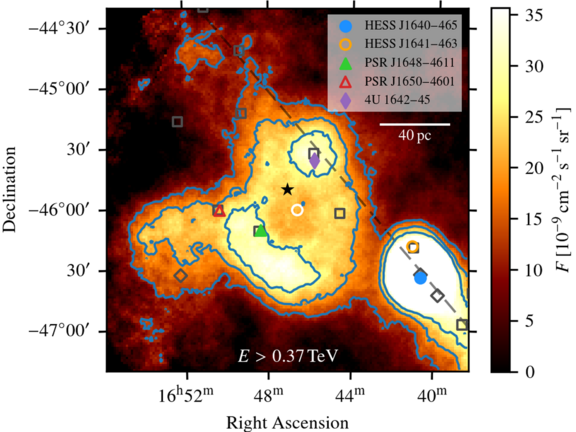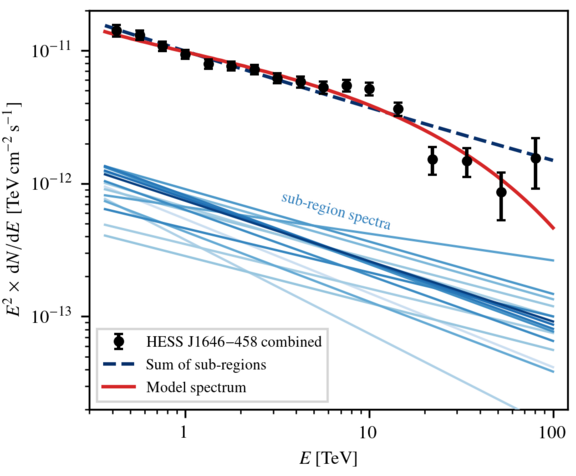Since more than 100 years, we know that cosmic rays – charged particles – are accelerated to extremely high energies in the Milky Way, our galaxy. And yet, we have still not fully uncovered their sources. While remnants of young and powerful supernova explosions have long been postulated to be the "culprits", recently young massive star clusters have become increasingly popular as potential major contributors to the flux of Galactic cosmic rays. This hypothesis can be tested by searching for high-energy gamma-ray emission – inevitably produced by the accelerated cosmic rays – from such clusters.
Westerlund 1, discovered by Bengt Westerlund in 1961, is the most massive known young star cluster in our Galaxy. It contains a large number of very massive stars, among them a significant fraction of all known Yellow Hypergiants and Wolf-Rayet stars. Its total mass is about 105 solar masses, half of which is located within a radius of ~1 parsec, or about 3 light years.
H.E.S.S. is an array of 5 gamma-ray telescopes located in Namibia; the Max Planck Institute for Nuclear Physics has played a major role in constructing and operating them. In 2012, the H.E.S.S. Collaboration has reported the detection of an extended gamma-ray source called HESS J1646–458, coincident in position with Westerlund 1 [1]. However, due to the limited data set available at the time, the emission could not firmly be linked with Westerlund 1. “Since then, the data collected on this source with the four 12 m-diameter telescopes of the H.E.S.S. array has almost quintupled – enabling us now to perform a much more detailed analysis of the gamma-ray emission”, says Lars Mohrmann, postdoc in the division of Jim Hinton at the MPIK and one of the corresponding authors of the new publication.
The gamma-ray emission of HESS J1646–458 extends over a region almost 2 degrees across, which corresponds to about 140 parsec (or 450 light years) – much larger than the star cluster itself, as shown by the map in Fig. 1. The structure of the source is quite complex: remarkably, the emission is not peaked at the position of Westerlund 1, but rather seems to exhibit a shell-like structure, with several bright peaks in addition. A detailed investigation of possible counterparts to the emission has revealed that only cosmic rays accelerated by Westerlund 1 can explain the observed gamma-ray emission.
The measured energy spectrum of HESS J1646–458 is shown in Fig. 2 (black data points). It extends to several tens of Tera-electronvolt, which unveils that Westerlund 1 is acting as a powerful cosmic-ray accelerator. The spectrum can be fitted well with models that explain the gamma-ray emission as originating from both, cosmic-ray protons or electrons.
In the publication, the authors discuss various possibilities where and how exactly the star cluster accelerates the cosmic rays. While no final conclusions could be drawn, the large spatial extent of the emission and its shell-like structure may indicate a connection with the collective wind of the cluster, which forms as a superposition of the stellar winds of all the massive stars inside Westerlund 1. If confirmed – possibly by high-resolution measurements with the upcoming Cherenkov Telescope Array, it would be the first time that the collective wind of a massive star cluster could be directly linked to high-energy gamma-ray emission, and thus be identified as a cosmic-ray acceleration site.
Original publication:
A deep spectromorphological study of the γ-ray emission surrounding the young massive stellar cluster Westerlund 1, H.E.S.S. Collaboration, Astronomy & Astrophysics, accepted (2022), DOI: 10.1051/0004-6361/202244323,
arXiv:2207.10921
Reference:
[1] A. Abramowski et al. (H.E.S.S. Collaboration), Astronomy & Astrophysics 537, A114 (2012).

